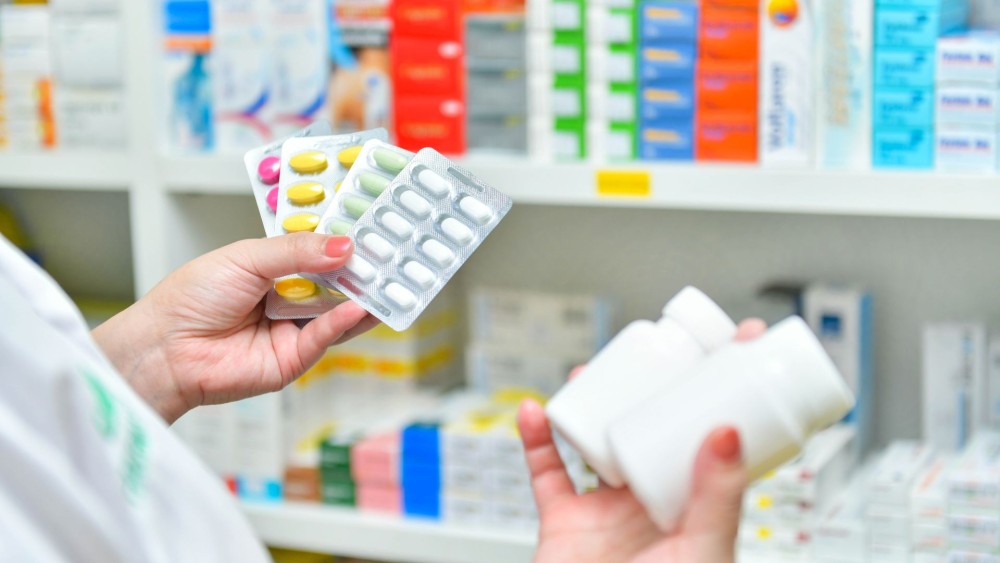Indonesia’s Planned Health Bill Opens More Room for Foreign Investment in Pharmaceutical Industry
21 Jun 2023

The value of Gross Domestic Product (GDP) at constant prices of Indonesia’s pharmaceutical sectors has shown a steady rise in the last five years: Rp 179.79 trillion (roughly US$11.98 billion in current exchange rates) in 2019 to Rp 235.48 trillion in 2022. Furthermore, although the high demand for pharmaceutical products is no longer as high as it was during the COVID-19 pandemic, the sector still manages to grow in GDP contribution in the last three years.
The government’s commitment to boost the nation’s capability in producing its own pharmaceutical product has a role in these developments. Within the Indonesian National Industrial Development Master Plan 2015-2035, the government includes the pharmaceutical industry as a ‘prioritized’ sector in enhancing the country’s industrial power, portraying the strong will of the current administration in getting the pharmaceutical sectors to grow.
The government’s effort to boost Indonesian’s pharmaceutical sectors continues in an upcoming Health Bill which was deliberated by the Indonesian Parliament in May of this year and then again this June. Based on the overall positive response from the parliament, the bill is likely to be approved.
The bill, according to Indonesian Health Minister Budi Gunadi Sadikin, aims to fulfill the community's right to health services by expanding access and by improving the quality of healthcare through allowing greater involvement of foreign entities in procuring hospital services, technological capability, human resources availability, and pharmaceutical products sufficiency.
As quoted from paragraph 5 of article 346 of the Health Bill: “The Central Government and Regional Governments can provide support for institutions and/or the public investing in research on pharmaceuticals and Medical Devices.”
This signals interest from the Indonesian government in allowing for more participations from foreign companies in conducting any activities relevant to healthcare products and services, research, as well as procurement.
Another example of the government’s openness for more involvement from foreign companies is article 345, which highlights the path in which the Central Government and Regional Governments can support business actors who take part in the effort to provide facilities of research and technology transfer in pharmaceutical production.
As stated in article 345: “The Central Government and Regional Governments carry out efforts to maintain Pharmaceutical and Medical Devices Supply through: a. issuance of policies and regulations including providing incentives to business actors who take part in efforts to materialize the resilience of Pharmaceutical Preparations and Medical Devices; b. providing facilities in the implementation of research and technology transfer to support the resilience of Pharmaceutical and Medical Devices Supply in the form of infrastructure, superstructure, budget and regulation facilitation.”
As argued by the Spokesperson for the Ministry of Health Dr. Mohammad Syahril, by opening investment opportunities for international quality hospital and healthcare services in Indonesia, the bill would give the public more choices in healthcare. The bill is also expected to reduce the number of Indonesian citizens seeking medical services and pharmaceuticals products abroad.
"[The bill serves] to increase services and market share for people who usually go to foreign countries for treatment. It is even hoped that foreigners will seek treatment here too and increase Indonesia's income," said Mohammad as quoted by the government’s official website Indonesia.go.id, on Thursday, May 11.
Indonesia’s pharmaceutical production and its limitations
Despite a steady increase in GDP contribution, Indonesia is still dependent on imports for the production of pharmaceutical products. It has been estimated that between 90-95% of all raw materials for the domestic industry are imported. The dependency on the foreign market is visible in the considerable degree of import value compared to export.
Exports and Imports of pharmaceutical products (HS Code: 30) in million US$
Export
|
Year |
Month |
Total |
|||||||||||
|
Jan |
Feb |
Mar |
Apr |
May |
Jun |
Jul |
Aug |
Sep |
Oct |
Nov |
Dec |
||
|
2020 |
48.26 |
49.12 |
55.36 |
43.34 |
44.73 |
54.70 |
56.72 |
45.62 |
54.52 |
45.91 |
48.73 |
45.71 |
592.72 |
|
2021 |
27.02 |
41.30 |
51.47 |
52.17 |
36.60 |
41.46 |
40.18 |
50.46 |
56.59 |
47.64 |
51.72 |
5939 |
556.00 |
|
2022 |
31.56 |
44.00 |
57.75 |
64.77 |
45.22 |
60.25 |
47.69 |
58.00 |
53.15 |
63.98 |
62.27 |
54.87 |
643.51 |
Import
|
Year |
Month |
Total |
|||||||||||
|
Jan |
Feb |
Mar |
Apr |
May |
Jun |
Jul |
Aug |
Sep |
Oct |
Nov |
Dec |
||
|
2020 |
90.46 |
82.64 |
77.44 |
99.24 |
94.84 |
125.99 |
89.36 |
101.56 |
96.71 |
87.23 |
102.16 |
111.10 |
1.158.73 |
|
2021 |
254.80 |
157.89 |
259.57 |
188.85 |
200.06 |
278.74 |
464.58 |
470.60 |
477.52 |
314.34 |
502.09 |
790.54 |
4.359.58 |
|
2022 |
289.51 |
81.45 |
159.06 |
111.83 |
110.90 |
108.82 |
102.31 |
95.00 |
83.26 |
139.40 |
98.98 |
130.97 |
1.511.49 |
Source: BPS
According to the World Health Organization, the 10 most prominent cause of deaths in Indonesia are stroke, heart attack, diabetes, tuberculosis, liver cirrhosis, chronic lung, diarrhea, hypertension, Respiratory Tract Infection (ISPA), and neonatal diseases. Indonesia’s capacity to produce medicines to make its citizens safe from these 10 causes of deaths is limited.
As of 2023, as declared by the Minister of Health Republic of Indonesia Decree No. Hk.01.07/Menkes/1333/2023 on increasing the use of pharmaceutical preparations using domestic production and raw materials, there are 62 items of medicinal raw materials that can currently be produced domestically and are ready for use. They consist of 45 items of Active Pharmaceutical Ingredient (API) medicinal raw materials, two items of natural raw materials, three items of raw material for biological products, and 12 items of active vaccine and serum-active substances.
Top 10 Causes of death in Indonesia and domestic medicine production capacity
|
No |
Cause of Death |
Required Medicine |
Treatment Produced domestically |
|
1. |
Stroke |
Platelet antiaggregation, klopidogrel, silostazol, tikagrelor, trombolitik, alteplase, streptokinase. |
klopidogrel |
|
2. |
Heart Attack |
Morfin, deksmedetomidin, ikofenolat mofetil, sildenafil, pravastatin, karvedilol, isosorbid dinitrat, digoksin, furosemide, ivabradin, kandesartan, kaptopril, karvedilol, milrinon, ramipril, sacubitril, spironolakton, bisoprolol, dobutamin, dopamine, epinefrin, norepinefrin. |
bisoprolol & sacubitril |
|
3. |
Diabetes |
akarbose, glibenklamid, six types of insulin, gliklazid pravastatin, glikuidon, glimepiride, glipizide, metformin, pioglitazone, sitagliptin, vildagliptin. |
glimepirid & sitagliptin |
|
4. |
Tuberculosis |
bedakuilin fumarate, delamanid, isoniazid, OAT KDT Categories, pirazinamid, streptomisin, rifampisin, etambutol. |
rifampisin |
|
5. |
Liver cirrhosis |
adefovir dipivoksil, daklatasvir, entekavir, lamivudine, pegylated interferon, pegylated interferon alfa-2a, pegylated interferon alfa-2b, ribavirin, sofosbuvir, telbivudin, tenofovir, mikofenolat mofetil, tacrolimus, everolimus, ect |
lamivudin & tenofovir |
|
6. |
Chronic lung |
Dosetaksel, indakaterol, glikopironium, salbutamol, salmeterol, flutikason propionate, tiotropium, olodaterol, tiotropium. |
N/A |
|
7. |
Diarrhea |
Atapulgit, oralit salt, loperamid, zinc, kaolin, pectin. |
atapulgit |
|
8. |
Hypertension |
Amlodipin, atenolol, bisoprolol, diltiazem, doksazosin, hidroklorotiazid, imidapril, irbesartan, kandesartan, kaptopril, klonidin, klortalidon, Lisinopril, metildopa, metoprolol tartat, nifedipin, nikardipin, nimodipin, perindopril arginine, telmisartan, prostaglandin (PGE 1), ramipril, valsartan, verapamil, beraprost sodium, iloprost, sildenafil. |
amlodipin, bisoprolol, telmisartan, valsartan |
|
9. |
Respiratory Tract Infection (ISPA) |
kodein, n-asetil sistein, oksimetazolin, benzatin benzilpenisilin, fenoksimetil penisilin, amoksisilin, eritromisin, klaritromisin, azitromisin, kloramfenikol, ect |
azitromisin |
|
10. |
Neonatal |
povidon iodin, surfaktan, vaksin hepatitis B rekombinan, prostaglandin, tetrasiklin, ect |
povidone iodin, hepatitis B vaccine |
Source: World Health Organization, Decree of the Minister of Health of the Republic of Indonesia Number Hk.01.07/Menkes/6485/2021 Concerning the National Formulary, Decree of the Minister of Health of Republic of Indonesia Number Hk.01.07/Menkes/1333/2023 Concerning Increasing the Use of Pharmaceutical Preparations Using Domestic Production Raw Materials. Among the ten deadly causes of death, neonatal, ISPA, cirrhosis, are not specifically mentioned by the Decree Number Hk.01.07.
Decree of the Minister of Health of the Republic of Indonesia No. HK.01.07 modulates the drugs needed and used as reference for writing recipes on the implementation of health services to citizens in regard to the country’s national health insurance program. From this decree, we can identify what medicines the government recommends using in responding to certain illnesses. Unfortunately, Indonesia is only able to domestically produce 16 out of the 120 necessary medicines.
For investors, the limitations the country faces in producing medicines for crucial disease shows that the country still needs imports to provide quality healthcare to its citizens. Through the Health Bill, the desire is not only to resolve the limitations of drug production, but also to leverage Indonesia's effort in becoming a leading pharmaceuticals-producing country in Southeast Asia.
(Exchange Rate: US$1 = Rp 14,999.55)

